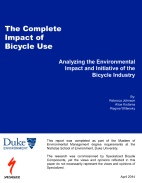Cycling is environmentally cool, right? Cyclists are not merely friends of the Earth but lovers, carers and life-long best mates, right? Bicycles are as benign as a gentle breeze wafting a summer meadow, right? Wrong. A new report says otherwise. It lays bare the impact that manufacturing bikes has on the environment. It’s not pretty.
 Just in case you suspect that it’s propaganda put out by the roads lobby or auto industry, you should know that it’s actually been produced at the expense of, and with huge help from, the third largest US bike seller, Specialized. With their income from 9% of the US bicycle market, they’ve paid three post-graduates at Nicholas School of Environment, Duke University, to dig the dirt on how much of our planet’s resources are used and abused to make the machines we love.
Just in case you suspect that it’s propaganda put out by the roads lobby or auto industry, you should know that it’s actually been produced at the expense of, and with huge help from, the third largest US bike seller, Specialized. With their income from 9% of the US bicycle market, they’ve paid three post-graduates at Nicholas School of Environment, Duke University, to dig the dirt on how much of our planet’s resources are used and abused to make the machines we love.
It’s a big report. There’s a massive amount of detail. It deserves to be studied and the facts and figures broadcast, published and gossipped. Such as the fact that it takes more than 30,000 litres of water to make just one Roubaix fork. Specialized uses enough water making Roubaix frames to supply the water needed by 477,000 people per year. “These numbers are staggering”, say the authors.
Making a a kilogram of a carbon frame uses 45% more water than an aluminium frame but, getting its own back in the race to deplete the planet, aluminium frames require more energy during their manufacture. “Over 58.7 gigawatt-hours are used per year to produce all the Allez framesets sold in a year, which is enough power to supply New York City for approximately 128 hours. The Allez frame’s most energy intensive process is artificially aging the aluminum frame to achieve specific metallurgy properties. This requires the frame to be heat treated at 400°F for ten hours.”
the planet, aluminium frames require more energy during their manufacture. “Over 58.7 gigawatt-hours are used per year to produce all the Allez framesets sold in a year, which is enough power to supply New York City for approximately 128 hours. The Allez frame’s most energy intensive process is artificially aging the aluminum frame to achieve specific metallurgy properties. This requires the frame to be heat treated at 400°F for ten hours.”
Other figures are equally shocking. In making all of the Allez framesets that are sold in a year, 6.4 million kilos of carbon dioxide equivalent are released into the atmosphere. To make the Roubaix frame, 1.01kg of waste are generated. For every kilogram of chain produced, there’s an astonishing 3.69kg of waste.
I won’t go on – you can read, open-mouthed, all 179 pages of the report yourself. Download it here. And do compare it with the impacts of other forms of travel, as detailed in the first chapter of my book, Cycling Science.
Of course, Specialized doesn’t do any of the manufacturing itself. It’s done mostly in China and Taiwan, with some components made in Japan. Each country, and each region within it, has different environmental goals. Some even have to meet national or international standards.
And Specialized must be applauded for being so candid about the impact that the making of their bikes is having on Earth. If ths publication can encourage other manufacturers to be equally transparent then there is hope that they will all work together to reduce their eco-footprint – not to boost cycling’s genuine green credentials but for the sake of the planet.

01/05/2014 at 10:01 pm |
I am riding an old Raleigh Twenty that had been abandoned in a shed years ago. I rescued it from being taken to the dump and spent half an hour pumping up the tyres, oiling the chain and adjusting the brakes. It obviously used some resources in its original manufacture (no aluminium or carbon fibre though) but I would say that it is a pretty green way for me to get around.
02/05/2014 at 5:23 am |
[…] How green is your bike? Ask Specialized […]
05/05/2014 at 5:57 pm |
ianji’s points are well taken.
(a) bikes used to be made of far less energy intensive materials, and their manufacture did not span the globe, and
(b) sticking with a bike, maintaining it for a lifetime or even half a lifetime goes a long way to amortizing the energy and materials required for its manufacture.
The problems this report therefore highlights in my view are the
– breathless obsolescence that seems to have now overwhelmed the bicycle sector, and
– the race to high performance materials that have (in some cases) staggering ecological footprints.
25/03/2015 at 5:43 pm |
All of this is meaningless when compared to far more water intensive products, like a car (39,090 gallons of water) and the gas it uses (then add infrastructure, etc.). Low-tech steel bikes are still the most environmentally friendly form of transit, all things considered. Not too sure about the “high-tech” components Specialized makes for their wannabe professional customers…